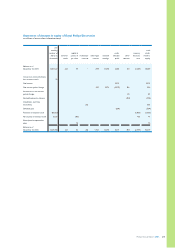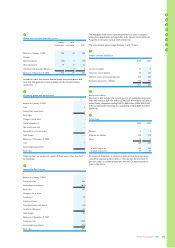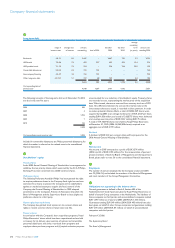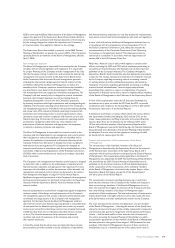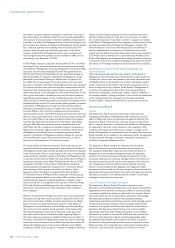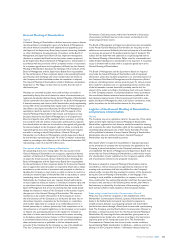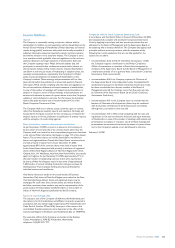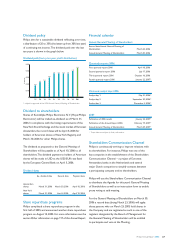Philips 2005 Annual Report Download - page 220
Download and view the complete annual report
Please find page 220 of the 2005 Philips annual report below. You can navigate through the pages in the report by either clicking on the pages listed below, or by using the keyword search tool below to find specific information within the annual report.Philips Annual Report 2005220
termination, severance payment is limited to a maximum of one year’s
base salary subject to mandatory Dutch law, to the extent applicable; if
the maximum of one-year’s salary would be manifestly unreasonable for
amemberoftheBoardofManagementwhoisdismissedduringhisrst
termofofce,thememberoftheBoardofManagementshallbeeligible
for a severance payment not exceeding twice the annual salary. The
Company does not grant personal loans, guarantees or the like to
members of the Board of Management, and no such (remissions of)
loans and guarantees were granted to such members in 2005, nor are
outstanding as per December 31, 2005.
In 2003, Philips adopted a Long-Term Incentive Plan (‘LTIP’ or the ‘Plan’)
consisting of a mix of restricted shares and stock options for members
of the Board of Management, the Group Management Committee, Philips
executives and other key employees. This Plan was approved by the
2003 General Meeting of Shareholders. Future substantial changes to
the Plan applicable to members of the Board of Management will be
submitted to the General Meeting of Shareholders for approval. As
from2002,theCompanygrantsxedstockoptionsthatexpireafter
ten years to members of the Board of Management (and other grantees).
Theoptionsvestafterthreeyearsandmaynotbeexercisedintherst
three years after they have been granted. Options are granted at fair
market value, based on the closing price of Euronext Amsterdam on the
date of grant, and neither the exercise price nor the other conditions
regardingthegrantedoptionscanbemodiedduringthetermofthe
options, except in certain exceptional circumstances in accordance with
established market practice. The value of the options granted to members
of the Board of Management and other personnel and the method
followed in calculating this value are stated in the notes to the annual
accounts.Philipsisoneoftherstcompaniestohaveintroduced
restricted shares as part of the LTIP. A grantee will receive the restricted
shares in three equal installments in three successive years, provided he/
she is still with Philips on the respective delivery dates. If the grantee
still holds the shares after three years from the delivery date, Philips
will grant 20% additional (premium) shares, provided he/she is still
with Philips. The Plan is designed to stimulate long-term investment in
Philips shares. To further align the interests of members of the Board
of
Management and shareholders, restricted shares granted to these
members
of the Board of Management shall be retained for a period
ofatleastveyears,insteadforaperiodofthreeyears,oruntilat
least the end of employment, if this period is shorter.
The actual number of long-term incentives (both stock options and
restricted shares) that are to be granted to the members of the Board
of Management will be determined by the Supervisory Board and depends
on the achievement of the set team targets in the areas of responsibility
monitored by the individual members of the Board of Management and
on the share performance of Philips. The share performance of Philips is
measured on the basis of the Philips Total Shareholder Return (TSR)
compared to the TSR of a peer group of 24 leading multinational
electronics/electrical equipment companies over a three-year period;
the composition of this group is described in the Report of the
Supervisory Board that begins on page 60 of this Annual Report.
The TSR performance of Philips and the companies in the peer group
is divided into quintiles. Based on this relative TSR position at the end
of December, the Supervisory Board establishes a multiplier which
varies from 0.8 to 1.2 and depends on the quintile in which the Philips
TSR result falls. Every individual grant, the size of which depends on
the positions and performance of the individuals, will be multiplied
by the multiplier.
Members of the Board of Management hold shares in the Company for
the purpose of long-term investment and are required to refrain from
short-term transactions in Philips securities. According to the Philips’
Rules of Conduct on Inside Information, members of the Board of
Management are only allowed to trade in Philips securities (including
the exercise of stock options) during ‘windows’ of ten business days
following the publication of annual and quarterly results (provided
the person involved has no ‘inside information’ regarding Philips at
that time) unless an exemption is available. Furthermore, the Rules of
Procedure of the Board of Management contain provisions concerning
ownership of and transactions in non-Philips securities by members of
theBoardofManagementandtheannualnoticationtothePhilips
ComplianceOfcerofanychangesinamember’sholdingsofsecurities
related to Dutch listed companies. In order to avoid the impression
that the Company should or could take corrective action in respect
of a certain transaction in securities in another company by a member
of the Board of Management and the unnecessary administrative burden,
the Supervisory Board and the Board of Management consider this
annualnoticationtobeinlinewithbestpracticesandsufcientto
reach an adequate level of transparency; however, it does not fully
comply with the Dutch Corporate Governance Code recommendation
II.2.6whichrequiresnoticationonaquarterlybasis.Membersofthe
Board of Management are prohibited from trading, directly or indirectly,
in securities in any of the companies belonging to the above mentioned
peer group of 24 leading multinational electronics/electrical companies.
IndemnicationofmembersoftheBoardofManagementand
Supervisory Board
Unless the law provides otherwise, the members of the Board of
Management and of the Supervisory Board shall be reimbursed by the
Company for various costs and expenses, such as the reasonable costs
of defending claims, as formalized in the articles of association. Under
certain circumstances, described in the articles of association, such as
an act or failure to act by a member of the Board of Management or
a member of the Supervisory Board that can be characterized as
intentional (“opzettelijk”), intentionally reckless (“bewust roekeloos”)
or seriously culpable (“ernstig verwijtbaar”), there will be no entitlement
to this reimbursement. The Company has also taken out liability
insurance(D&O-Directors&Ofcers)forthepersonsconcerned.
Supervisory Board
General
The Supervisory Board supervises the policies of the executive
management (the Board of Management) and the general course of
affairs of Philips and advises the executive management thereon. The
Supervisory Board, in the two-tier corporate structure under Dutch
law, is a separate body that is independent of the Board of Management.
Itsindependentcharacterisalsoreectedintherequirementthat
members of the Supervisory Board can be neither a member of the
Board of Management nor an employee of the Company. The Supervisory
Board considers all its members to be independent under the applicable
US Securities and Exchange Commission standards and pursuant to
the Dutch Corporate Governance Code.
The Supervisory Board, acting in the interests of the Company
and the Group and taking into account the relevant interest of
the Company’s stakeholders, supervises and advises the Board of
Management in performing its management tasks and setting the
direction of the Group’s business, including (a) achievement of the
Company’s objectives, (b) corporate strategy and the risks inherent in
the business activities, (c) the structure and operation of the internal
riskmanagementandcontrolsystems,(d)thenancialreporting
process, and (e) compliance with legislation and regulations. Major
management decisions and the Group’s strategy are discussed with and
approved by the Supervisory Board. In its report, the Supervisory Board
describesitsactivitiesinthenancialyear,thenumberofcommittee
meetings and the main items discussed.
Rules of Procedure of the Supervisory Board
The Supervisory Board’s Rules of Procedure set forth its own
governance rules (including meetings, items to be discussed, resolutions,
appointmentandre-election,committees,conictsofinterests,trading
insecurities,proleoftheSupervisoryBoard).Itscompositionfollows
theprole,whichaimsforanappropriatecombinationofknowledge
and experience among its members encompassing marketing,
technological,manufacturing,nancial,economic,socialandlegalaspects
of international business and government and public administration
in relation to the global and multi-product character of the Group’s
businesses. The Supervisory Board further aims to have available
appropriate experience within Philips by having one former Philips
executive as a member. In line with US and Dutch best practices, the
Chairman of the Supervisory Board should be independent under
the applicable US standards and pursuant to the Dutch Corporate
Governance Code; because this provision does not exclude a former
Philips executive from being Chairman of the Supervisory Board, but
only if he or she meets these standards, it is not fully in line with
Corporate governance





